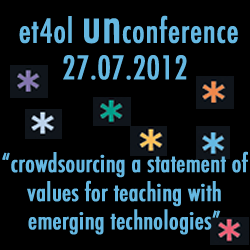A vote for unconferences
 Funny thing about conferences…
Funny thing about conferences…
Most are not effective at one of their primary goals: learning. I rarely enjoy the deep learning experiences that I expect at professional conferences. Instead, I leave most conferences having experienced rich networking and professional interactions and some introduction to new information or ideas. It’s sad that, while conferring with a colleague yesterday, we agreed that we are often happy when we take away “just one good idea” from a conference. Good grief.
Based on the surge of “unconferences” popping up everywhere, I don’t think I’m the only one who feels cheated by many professional conferences. In theory, unconferences are a fun, grassroots, and sometimes rage-against-the-machine approach to professional development. But even unconferences struggle with the balance between anarchy and organization and often fall short of their stated goals.
That’s why I was hesitant to attend the unconference at last week’s Sloan-C/MERLOT Emerging Technologies for Online Learning (henceforth, ET4Online) conference in Las Vegas. If any conference needed a successful unconference, it was this one and I think Jen Ross (the organizer extraordinaire of the unconference) delivered. The ET4Online unconference was by leaps and bounds the most useful, engaging (Beetlejuice!), and fun part of the conference.
Here are some things that made this unconference so rockin’:
Pre-unconference discussions and videos – Jen worked hard before and during the conference to network with people who could contribute good ideas to the unconference discussions. With some of those people (ones with whom she could coordinate schedules), she led Google Hangout interviews to prime attendees for the discussions. She aggregated those videos on an ET4Online unconference Google+ page. All of this work, I think, helped to connect people to the event before it even began. I’ll admit that, if Jen had not engaged me the way she did (Beetlejuice!), I probably would not have attended the session.
The right people – I was surprised that 40ish people attended this session. These 40 participated, presumably, because they wanted to be there, to contribute their voice to the discussion, and to participate in more intensive activities with their colleagues. Because of this, I would argue that the right people were in the room for the unconference. In many conference sessions, you may find colleagues who are more invested in reading their email than in being active participants in the sessions. But at the unconference session, the attendees were invested in participating, contributing, and learning from each other.
Organization and guidance, without too much control – I think that many unconferences start to unravel at the organizational level. For the ET4Online conference, Jen seemed to find the right balance of organization and responsiveness to the direction of the discussions. Throughout the activities– a short presentation from Jen, group discussions, and the fishbowl panel–Jen gave us guidance without getting in the way. I won’t elaborate any further on how the unconference was structured, but if you want to know more, check out this nice post from my new colleague Rob Darrow.
The online participants – Jen took advantage of Google+ tools and invited an online community to the discussions. This is a great idea and, though the practice could be improved a little, I think every conference should find better ways to connect its virtual attendees to its on-site attendees.
Here are some things that might make next year’s unconference even rockin’-er:
1. Weave unconference interactions throughout the conference, culminating in the mother-of-all-unconference sessions. During the final part of the unconference session, the fishbowl panel, several attendees voiced hopes that next year’s unconference could weave throughout the “regular” conference sessions. I agree. Get the discussions started early in the conference, find ways to continue discussions within sessions, on Twitter, during breaks, and then conclude with a wicked wrap-up session.
2. Offer libations. It’s something I’ve learned in my time in the academe: Meetings can be so much more productive when there’s a bottle of wine and yummy food in the room.
3. Facilitate more coordination and integration with the online participants. This one is tricky, I know, but there must be more ways to include members of the online audience in the discussion. Kudos to the ET4Online organizers for making a valiant effort by having a dedicated moderator in each session who asked the presenters questions on behalf of the online attendees. But what more could be done? I’d love to read your thoughts on this.
Want to see the result of the ET4Online unconference? Check out our early manifesto work and follow the Google+ page.
Before I end this post, I want to make one final plea to the conference organizers for Sloan-C and other academic/ed tech conferences. Please find ways to encourage more interactive sessions. I commend the ET4Online organizers (bravo, David Wicks!) for experimenting with flipped conference sessions. With a little more organization and preparation, I think that approach holds promise. Please, for the sake of all of us who attend these conferences to learn, please continue looking for ways to help enrich our learning experiences.
2 Responses